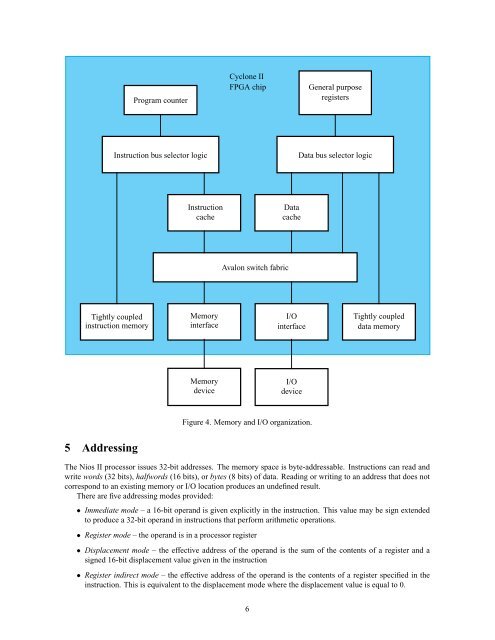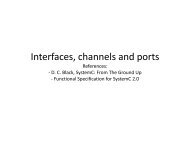Introduction to the Altera Nios II Soft Processor - FTP - Altera
Introduction to the Altera Nios II Soft Processor - FTP - Altera
Introduction to the Altera Nios II Soft Processor - FTP - Altera
Create successful ePaper yourself
Turn your PDF publications into a flip-book with our unique Google optimized e-Paper software.
Program counter<br />
Cyclone <strong>II</strong><br />
FPGA chip<br />
General purpose<br />
registers<br />
Instruction bus selec<strong>to</strong>r logic<br />
Data bus selec<strong>to</strong>r logic<br />
Instruction<br />
cache<br />
Data<br />
cache<br />
Avalon switch fabric<br />
Tightly coupled<br />
instruction memory<br />
Memory<br />
interface<br />
I/O<br />
interface<br />
Tightly coupled<br />
data memory<br />
Memory<br />
device<br />
I/O<br />
device<br />
Figure 4. Memory and I/O organization.<br />
5 Addressing<br />
The <strong>Nios</strong> <strong>II</strong> processor issues 32-bit addresses. The memory space is byte-addressable. Instructions can read and<br />
write words (32 bits), halfwords (16 bits), or bytes (8 bits) of data. Reading or writing <strong>to</strong> an address that does not<br />
correspond <strong>to</strong> an existing memory or I/O location produces an undefined result.<br />
There are five addressing modes provided:<br />
• Immediate mode – a 16-bit operand is given explicitly in <strong>the</strong> instruction. This value may be sign extended<br />
<strong>to</strong> produce a 32-bit operand in instructions that perform arithmetic operations.<br />
• Register mode – <strong>the</strong> operand is in a processor register<br />
• Displacement mode – <strong>the</strong> effective address of <strong>the</strong> operand is <strong>the</strong> sum of <strong>the</strong> contents of a register and a<br />
signed 16-bit displacement value given in <strong>the</strong> instruction<br />
• Register indirect mode – <strong>the</strong> effective address of <strong>the</strong> operand is <strong>the</strong> contents of a register specified in <strong>the</strong><br />
instruction. This is equivalent <strong>to</strong> <strong>the</strong> displacement mode where <strong>the</strong> displacement value is equal <strong>to</strong> 0.<br />
6

















